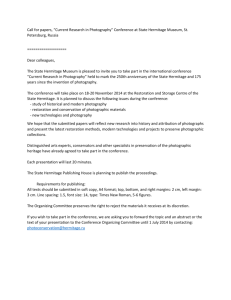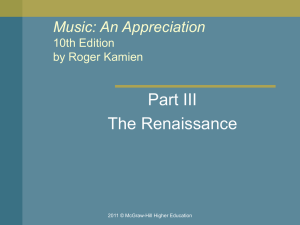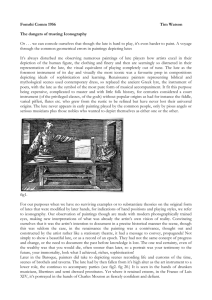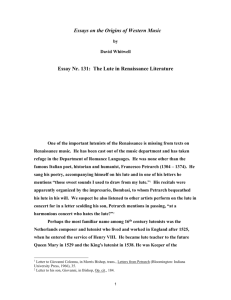Lute News 116.indd
advertisement
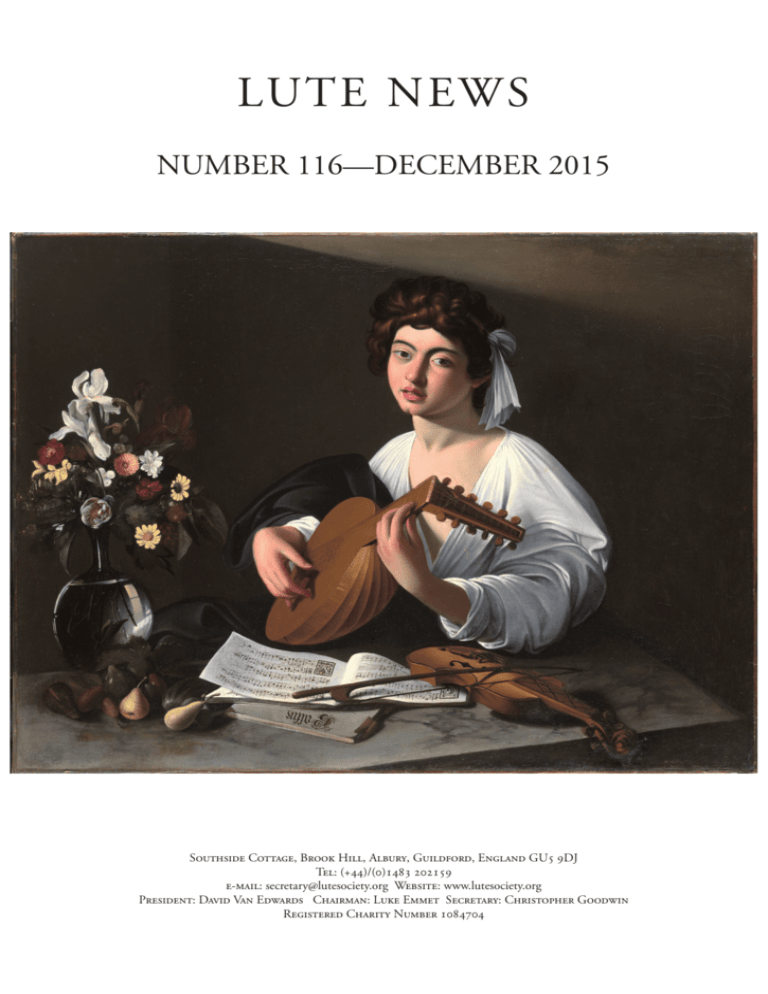
LUTE NEWS NUMBER 116—DECEMBER 2015 Southside Cottage, Brook Hill, Albury, Guildford, England GU5 9DJ Tel: (+44)/(0)1483 202159 e-mail: secretary@lutesociety.org Website: www.lutesociety.org President: David Van Edwards Chairman: Luke Emmet Secretary: Christopher Goodwin Registered Charity Number 1084704 Lute News 116, December 2015 2 Detail, Badminton version Detail, Hermitage version The Lute Player, Wildenstein version The Lute Player, Hermitage version COVER PICTURE by David van Edwards The Lute Player c.1596, Caravaggio, Private Collection, London You probably think you recognise the cover picture as the iconic six-course Lute Player c.1600, by Caravaggio, in the Hermitage museum. Or even, if you have glanced at the inside cover, that it might be the rather dodgy version of that painting which I discussed in detail, and questioned the authenticity of, in Lute News 50 June 1999 (Now online at: www.vanedwards.co.uk/month/jun99/ month.htm). That one is part of the Wildenstein Collection and has been on loan to the Metropolitan Museum, New York where it was the subject of a special exhibition and glossy catalogue in 1990 and was then shown in London in the ‘Genius of Rome’ exhibition in 2001. It seems likely that this inferior Wildenstein version was commissioned from a different artist by someone who wanted to display his own assemblage of possessions in substantially the same schema, the table carpet, the recorder, the spinettino and the more up-to-date seven-course lute. This latter is clearly copied from Caravaggio’s other lute playing painting, The Musicians, now in the Metropolitan Museum which was commissioned by Cardinal Del Monte, Caravaggio’s patron. Del Monte’s friend and neighbour Marchese Vincenzo Giustiniani owned the Hermitage version of our Lute Player, he also owned the explicitly erotic Amor Vincit Omnia by Caravaggio which he kept in a private room screened by a green silk curtain. However, it is neither the Hermitage or the Wildenstein. Rather it is yet another and much more convincing version. It had been lanquishing in plain view in Badminton House, Gloucestershire and widely disregarded as an inferior copy under its thick layer of yellow varnish until it came up for auction in Sotheby’s New York in January 2001. Then it was examined more closely and has recently been properly cleaned and is in a private collection in London where I had the opportunity to look at it. This exBadminton painting is much closer to the Hermitage version and, surprisingly perhaps, even closer to the 1642 description by Giovanni Baglione of a painting done by Caravaggio for his patron Cardinal Del Monte: E dipinse [per il Cardinale Del Monte]… anche un giovane, che sonava il Lauto, che vivo, e vero il tutto parea con una caraffa di fiori piena d’acqua, che dentro il reflesso d’ua fenestra eccelentemente si scorgeva con altri ripercotimenti di quella camera dentro l’acqua, e sopra quei fiori eravi una viva rugiada con ogni esquisita diligenza finta. E questo (disse) che fu il piu bel pezzo, che facesse mai. (He also painted [for Cardinal Del Monte] a young man, playing the Lute, who seemed altogether alive and real with a carafe of flowers full of water, in which you could see perfectly the reflection of a window and other reflections of that room inside the water, and on those flowers there was a lively dew depicted with every exquisite care. And this (he said) was the best piece that he ever painted.) The Hermitage painting has no dew on the flowers, and the reflection in the carafe is only a tiny streak and doesn’t seem to show a window or any other part of the room. But both of these details are present in the ex-Badminton painting, giving its provenance a very convincing terminus a quo. Apart from those rather telling differences, the paintings are so similar that it seems clear that both are genuine Caravaggios. But for us, perhaps one of the most interesting things is that the lute on the cover, the ex-Badminton, unlike the Hermitage version, has been converted into a seven-course instrument. Both the Hermitage and the ex-Badminton lutes have the same twelve randomly unmatched pegs with three different peghead designs. In both cases the top peg is shown as worn far into the pegbox side and is clearly nearly in need of being replaced by another peg with a thicker shank. This is of course the most used peg and the most likely to wear through, which makes one more inclined to trust the observation of the other details. The random nature of the pegheads suggests that this has already happened with other pegs, implying a very well-used old instrument. But when you look closely at the nut and the strings, you see that the ex-Badminton has a single top string, not the double top course of the Hermitage lute and that the spare peg thus freed has been used for one thick single seventh-course string. The nut looks to have had some later paint added on the treble side which might have obscured an empty groove for the second string of a double top but the single string is clearly shown both as it crosses the nut and as it passes along the fingerboard and over the front. At the far, bass, end of the nut the double sixth course, fundamental and octave, is followed by the single very thick string of the seventh course. Compare the two details on the inside front cover. It is at first difficult to read the strings crossing the nuts because Caravaggio has also painted the reflective sides of the nut grooves, so disentangling string from groove is not straightforward. But if you follow it through carefully you will see the clear gap between the thick seventh-course string and the fingerboard, and no octave string. And if you count the strings as they pass over the soundboard, the tale is the same, single top and single seventh. The Hermitage version is equally clear, it’s a normal six-course, double strung throughout in the Italian fashion. It is known both that Cardinal del Monte had a collection of instruments and that Caravaggio was famous in his own time for painting from the life, so there is every reason to believe that these were actual lutes or probably one lute in two different stringings. They are clearly old lutes which have been played enough to need some of their pegs replacing; also the fingerboard ending in a straight line at the neck/body joint is an old-fashioned detail for a lute of the late 1590s, especially for an Italian lute at this time of peak production of high-quality lutes in North Italy. It is also unusual for a new lute of this period to have no ebony protective edge to the soundboard. The bridge ends are not clear on the ex-Badminton lute but the Hermitage version seems to have the forward curl ending with a little flower such as we often see in paintings from earlier in the sixteenth century and on the bridge of the surviving Gerle lute. (This lute also has no protective ebony edge but is often dated to c.1580; however there isn’t really much evidence and several makers have remarked that it seems a bit old-fashioned for that date, perhaps Innsbruck was a bit behind the latest styles of Venice and Padua.) All these details and the beautifully observed worn and 5 Lute News 116, December 2016 shiny edge to the soundboard and the badly cracked rib, point to an old lute probably made c.1520 that has been through the wars a bit but is still playable and good enough to warrant the minor modification of stringing to enable it to play the current (for the 1590s) seven-course music. But of course there is also symbolism to the cracked rib. In fact there are signs of decay and mortality throughout both the ex-Badminton and Hermitage paintings, from the huge crack in the neck of the violin, the broken and splayed black hairs on the violin bow with its clip-in frog, to the bruised pears on the table. Even the glass carafe looks to be rather too close to the back edge of the marble table for safety—this beauty is a fragile construct. It is known that Cardinal Del Monte, Caravaggio’s patron and in one of whose homes he was living at the time of these paintings, had a thorough and educated interest in music. He was elected to several important musical offices in Rome, Pope Clement VIII put him in charge of the reform of liturgical music, several composers dedicated works to him and he was a close friend of Cavalieri. It has been suggested, on no particular evidence, that the lute player himself might be Pedro Montoya, a young castrato who was also a member of del Monte’s household at the time, though the artist’s model could equally well have been a catamite of Caravaggio’s. The Cardinal was indeed accused of homosexual leanings, though this may have been a deliberate slander designed to reduce his chances of the papacy at a time when the Counter-Reformation church was officially rather puritanical. However it is tempting to read such feelings into the text of the madrigal by Jacques Arcadelt visible in the music on the table. ‘Vous savez que je vous aime et vous adore . . . Je fus vôtre’ (You know I love you and adore you . . . I was yours). Interestingly these words are not shown in the music print we see, just the initial V of the French text and then the words ‘. . . Oi sapete che’ (You know that) written between the staves, suggesting a need to keep the message slightly secret—remember Giustiniani’s painting behind a curtain. And this of course feeds into the transience of things and the palpable yearning of the picture as a whole: the dew on the flowers echoing the pretty face of the young boy and the presumed beauty of the playing and the song, all undercut by the bruised fruit and the fragile cracked instruments. Even Caravaggio’s trademark style of a shaft of light amid the circumambient gloom carries the same freight of melancholy; he painted the walls of his studio black to acheive this effect. This is not quite the same easy moralising tone of the standard North European Vanitas paintings, or even of the more complex Ambassadors by Holbein with its broken string and anamorphic death’s head; this has an undercurrent of guilty pleasure. That French bishop and his companion in The Ambassadors look casually confident of their mastery of the symbolism in their portrait; they know what a clever painting they have commissioned. They don’t look in any way agonised or threatened by the transience of the symbols of intellectual and artistic achievement they have assembled between them. I suspect the Italian cardinal may have been a more troubled soul to have commissioned The Lute Player. Lute News 116, December 2015 The ex-Badminton painting on our cover has been known as Apollo the Luteplayer and the long Wikipedia entry on these three paintings makes the case that a representation of Apollo would have been a likely subject for a painting in Cardinal Del Monte’s studiolo, on whose ceiling Caravaggio had painted the gods Neptune, Jupiter and Pluto. It was after all commonplace to equate Apollo’s lyre with a lute. However it seems unlikely to me that Apollo would be represented with all those clear symbols of transience and mortality. Apollo should not be playing a cracked lyre! A more plausible line of enquiry might be the prevailing interest in neo-Platonism and particularly the passage in the Phaedo where Simmias associates harmony and music with the soul, and the lyre itself with the mortal body. He says to Socrates: . . . one might use the same argument about harmony and a lyre with its strings. One might say that the harmony is invisible and incorporeal, and very beautiful and divine in the well attuned lyre, but the lyre itself and its strings are bodies, and corporeal and composite and earthy and akin to that which is mortal. This metaphor seems to have been part of the contemporary zeitgeist; in 1517 Raphael had painted a famous St. Cecilia, commissioned by another cardinal, Lorenzo Pucci, for San Giovanni Monte in Bologna, where the cracked instruments are explicitly contrasted to heavenly harmony. As Lorenzo puts it beautifully in Act V of the Merchant of Venice written at exactly the same time as The Lute Player was being painted: Such harmony is in immortal souls, But whilst this muddy vesture of decay Doth grossly close it in, we cannot hear it. Would this not be a more acceptable sub-text to an erotic image for a cardinal! 6


